
Floor monitor system
This system is suitable for a performer’s monitoring system. For use as a vocal monitor, set the [D-CONTOUR] switch to [MONITOR].
If necessary, you can additionally connect up to four speakers in parallel. In this case we recommend that the signal is input to CH1 and the output switch is set to [CH1 THRU].
To next speaker
Mixer
Set to [CH1 THRU]Set to [CH1 THRU]
In order to take full advantage of the DBR series’ (referred to in this manual as DBR) superior functionality
and enjoy years of trouble-free use, please read this manual before you begin using the product. After you
have read the manual, keep it in a safe place for reference when needed.
• Please read the PRECAUTIONS on the reverse side of this manual before use.
• This manual uses example illustrations taken from the DBR12 if not otherwise specified.
• The illustrations as shown in this manual are for instructional purposes only, and may appear somewhat
different from those on your device.
• The company names and product names used in this manual are the trademarks or registered
trademarks of their respective companies.
Features
• FIR-X tuning™
Our proprietary sound-processing technology utilizing a linear-phase FIR filter delivers excellent sound quality
with high resolution and a smooth frequency response that is unaffected by phase interference near the
crossover point.
• D-CONTOUR (Dynamic CONTOUR)
D-CONTOUR optimizes the level of each frequency range according to the application to be used or the
listener’s preferences. There are two modes: an FOH/MAIN mode for use as a main speaker, and a MONITOR
mode for use as a floor monitor.
• Simple mixing function
The DBR features simple mixing functionality, enabling you to select either a direct output of channel 1 (CH1)
(parallel connection) or a mixed output of CH1 and CH2.
• Various input/output connectors
The comprehensive set of connectors—including XLR for a mixer, phone for a musical instrument, and RCA-
pin for an MP3 player—provides maximum flexibility in use with a wide variety of applications.
• Light weight, high power
A newly developed power supply and amplifier has enabled compact size and light weight, as well as
powerful output.
• Advanced protection functionality
DSP-controlled advanced protection functionality promotes optimum reliability even in challenging
environments.
Included Accessories
• AC power cord
• Technical Specifications (English only): includes specifications, block diagram, and dimensions.
• Owner’s manual (this leaflet)
ZJ41540
EN
POWERED SPEAKER SYSTEM
DBR series
Owner’s Manual
Simple system with a single DBR
This example illustrates the system when connecting directly to a microphone, musical instrument, or
background music source without using a mixer.
Main application: small-sized live venue, presentations, restaurants
Note
For CH2, inputs to the combo jack and to the RCA pin jacks will be mono mixed at a fixed balance. If you want to
change the balance, adjust the volume of the connected sound source.
Musical instrument
Microphone
Background music source
System with two DBRs and subwoofers
This system is the most suitable for a main speaker system. If desired, you can add another DBR to create
a floor monitor system.
Main application: small-sized live venue, house of worship, event site
Note
We recommend to use Yamaha DXS series (referred to in this manual as DXS) as a subwoofer. In this case,
we recommend that the DBR’s HPF cutoff frequency and the DXS’s LPF cutoff frequency are set to the same
settings; however, you can adjust it as desired.
R L
Subwoofer Mixer Subwoofer
1
Input jacks (CH1 and CH2)
These are balanced combo jacks that support both XLR and phone plugs (both CH1 and CH2), and RCA-
pin plugs (CH2 only). For the combo jacks, connect a mixer, microphone, or digital musical instrument
such as a keyboard. For RCA-pin jacks, connect a device such as an MP3 player or a CD player. For
devices with high level signals such as a mixer, connect to CH2, or connect to CH1 then set the [MIC/
LINE] switch (
3
) to [LINE].
XLR Phone RCA-pin
2
[LEVEL] knobs
Adjust the level of each input jack (
1
).
3
[MIC/LINE] switch
Set this switch to [MIC] or [LINE] for the CH1 jack, depending on the level of the input signal. For low-
level signals (such as microphones), set the switch to [MIC]. For high-level signals (such as mixer), set the
switch to [LINE].
4
Output switch
Selects the output signal sent to the output jack (
5
).
[CH1 THRU]: Delivers the direct output signal of CH1 only. Signal from CH2 will not be output.
[CH1+2 MIX]: Outputs the mixed signals of CH1 and CH2.
5
Output jack
This is a balanced XLR jack. This can be used to connect another DBR speaker. Outputs the signal
selected by
4
output switch.
6
[LIMIT] indicator
Indicates (lit in red) that the limiter is on when the output voltage of the amplifier has exceeded the
maximum level, or when excessive integral power consumption is detected. If this indicator stays lit, lower
the input level.
Note Integral power consumption refers to the sum of power provided to the speaker driver per unit time.
7
[SIGNAL] indicator
Indicates (lit in green) when an audio input signal exceeds the minimum threshold.
8
[PROTECTION] indicator
Indicates (lit in red) when the protection circuit is active. The protection circuit will be activated and the
speaker outputs will be muted in the situations listed below.
• If amplifier overheating is detected
• If overcurrent is detected
• When turning the power on; the protection circuit will be activated for a few seconds to prevent noise.
The indicator turns off when the power supply has started normally.
If the protection circuit has engaged, waiting until the amplifier cools down or powering off and on again
will return to normal operation. If the unit does not return to normal operation, please contact your Yamaha
dealer.
9
[POWER] indicator
Indicates (lit in green) when the [
/ ] (power) (
E
) switch is turned on.
0
[D-CONTOUR] indicator
Indicates (lit in yellow) when the [D-CONTOUR] switch (
A
) is set to [FOH/MAIN] or [MONITOR].
A
[D-CONTOUR] switch
Selects one of the D-CONTOUR (Dynamic CONTOUR) presets.
[FOH/MAIN]: Boosts the high and low frequency components so that the frequency response is suitable
for a main speaker.
[MONITOR]: Reduces the low frequency range, which could otherwise tend to be boomy if the speaker is
set directly on the floor. This enables you to hear mid and high frequency ranges clearly when using as a
floor monitor.
[OFF]: Turns off D-CONTOUR. This is a generic frequency response setting.
B
[HPF] switch
Selects the cutoff frequency of the high pass filter. If you set this switch to [120Hz] or [100Hz], the low
frequency components below each threshold will be cut. If you use the unit alone, set this switch to [OFF].
If you plan to use the unit along with a subwoofer, we recommend that you set this switch to [120Hz] or
[100Hz].
C
Vent
The unit contains a cooling fan. Since the air for cooling is taken in and expelled here, be careful not to
block this vent.
D
[AC IN] socket
Connect the supplied power cord here. First connect the power cord to the unit, then plug it into an
appropriate AC power outlet.
CAUTION
Turn off the power before you connect or disconnect the power cord.
E
[
/ ] (power) switch
Turns power to the unit on [
] or off [ ]. First, turn on the power of the connected sound source (external
device), then the unit. When turning off the power, reverse the order by turning off the power of the unit first
and then the connected sound source (external device).
CAUTION
Even when the switch is in the off position, a small amount of electricity is still flowing to the unit. If it will not be used for an
extended period of time, therefore, be sure to unplug the power cord from the wall AC outlet.
Note • Rapidly turning the unit on and off in succession can cause it to malfunction. After turning the unit off, wait for
about 5 seconds before turning it on again.
• If you are using multiple units, turn on the power to each unit one by one. If you turn on the power to multiple
units simultaneously, a temporary drop in the power voltage may occur, possibly resulting in abnormal operation
of the units.
F
Screw holes (M8)
Use these M8 size screw holes for installing separately sold brackets or commercially available eye bolts.
G
Pole socket
This socket adapts to commercially available speaker stands and speaker poles of 35 mm diameter.
Controls and Connectors
1
6
7
8
9
A
0
B
C
E
D
C
2
3
4
5
G
F
Setup Examples
Rear
Bottom
Troubleshooting
Symptom Possible causes Possible solution
Power does not turn on. The power cord is not connected properly. Connect the power cord all the way in so that it is firmly in place.
Power suddenly went off. The protection system has been activated, shutting
down the power supply.
Turn off the power, wait until the amplifier cools down, and then turn on again.
No Sound. The cable is not connected properly. Connect the cable all the way in so that it is firmly in place.
Sound is interrupted suddenly. The protection circuit has been activated, muting the
output.
Wait until the amplifier cools down. If the unit won’t automatically reset itself, turn off the power, and then on
again.
Sound howls (feedback). A microphone is directed toward the speaker. Aim the speaker away from the area where the microphone picks up sound.
Sound is amplified too much. Lower the volume of input device and locate the microphone more closely to the sound source.
Each speaker sound differs (if multiple speakers are
used).
Settings for each speaker differ. Set the [HPF] switch and [D-CONTOUR] switch of each speaker to the same positions.
Sound is
distorted.
The [LIMIT] indicator is off. Input volume is excessive. When the [MIC/LINE] switch is set to [MIC], and even if you lower the volume fully the sound is still distorted,
set the switch to the [LINE] position. If the sound is still distorted even if the switch has been set to [LINE],
lower the volume of the connected input devices.
The [LIMIT] indicator is on. Output volume is excessive. Turn the [LEVEL] knob to lower the output level to a point so that the [LIMIT] indicator lights only occasionally.
The microphone volume is too low. The [MIC/LINE] switch is set to [LINE]. Set the [MIC/LINE] switch to the [MIC] position.
Low and high frequency are unbalanced. The output limiter is active. Lower the input level or the output level until the [LIMIT] indicator lights occasionally.
If any specific problem should persist, however, please contact your Yamaha dealer.

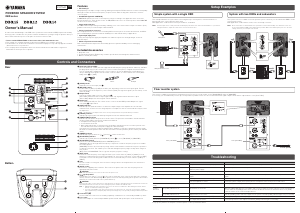


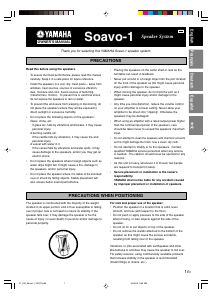
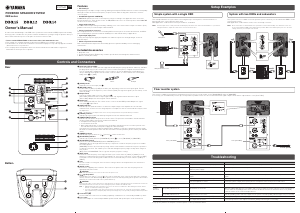
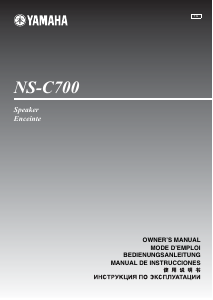
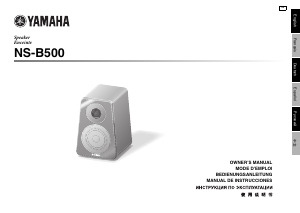
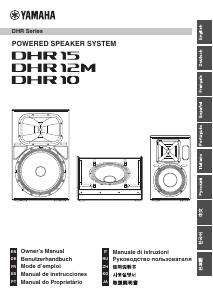
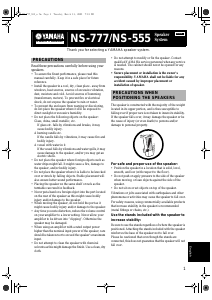
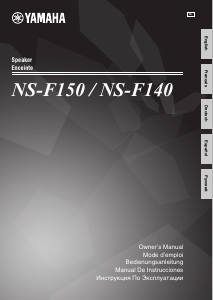

Join the conversation about this product
Here you can share what you think about the Yamaha DBR12 Speaker. If you have a question, first carefully read the manual. Requesting a manual can be done by using our contact form.